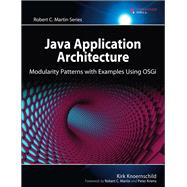Java Application Architecture Modularity Patterns with Examples Using OSGi

Java Application Architecture Modularity Patterns with Examples Using OSGi
- ISBN 13:
9780321247131
- ISBN 10:
0321247132
- Edition: 1st
- Format: Paperback
- Copyright: 03/15/2012
- Publisher: PEARSO
Rent
Sorry, this item is currently unavailable on Knetbooks.com
Note: Supplemental materials are not guaranteed with Rental or Used book purchases.
Extend or Purchase Your Rental at Any Time
Need to keep your rental past your due date? At any time before your due date you can extend or purchase your rental through your account.
Summary
"I'm dancing! By god I'm dancing on the walls. I'm dancing on the ceiling. I'm ecstatic. I'm overjoyed. I'm really, really pleased." From the Foreword by Robert C. Martin (a.k.a. Uncle Bob) This isn't the first book on Java application architecture. No doubt it won't be the last. But rest assured, this book is different. The way we develop Java applications is about to change, and this book explores the new way of Java application architecture. Modularity in software development is a concept that dates back to a seminal paper written by David Parnas in 1971, and modularity as a more general concept dates back several civilizations. How is it that modularity is such a big deal in Java application architecture going forward? The answer is that modularity is coming to the Java platform, and it will change the way we develop Java applications. This book will help you Design modular software that is extensible, reusable, maintainable, and adaptable Design modular software today, in anticipation of platform support for modularity Break large software systems out into a flexible composite of collaborating modules Understand where to place your architectural focus Migrate large-scale monolithic applications to applications with a modular architecture Clearly articulate the advantages of modular software to your team Over the past several years, module frameworks have been gaining traction on the Java platform, and upcoming versions of Java will include a new module system that will allow you to leverage the power of modularity to build more resilient, malleable, extensible, and flexible software systems. But you'll only be able to realize the benefits if you understand how to design more modular software systems. Java Application Architecturelays the foundation you'll need to incorporate modular design thinking into your development initiatives. Before it walks you through 18 patterns that will help you realize the benefits of modular software architecture, it lays a solid foundation that shows you why modularity is a critical weapon in your arsenal of design tools. Finally, it wraps up with several examples that demonstrate the patterns in action and the benefits. Throughout, you'll find ample examples that illustrate the concepts. By beginning to design modular applications today, you are positioning yourself for the platform and architecture of tomorrow. That's why Uncle Bob is dancing.








